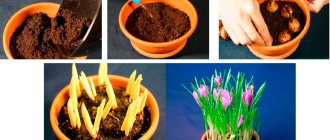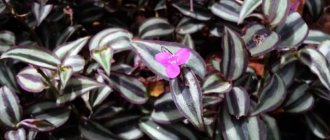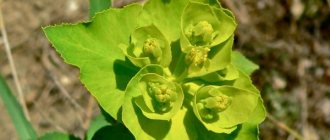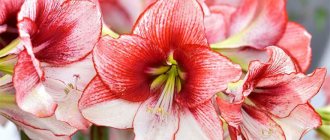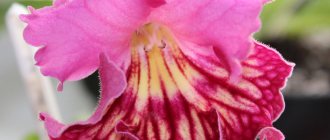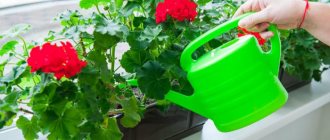As a rule, it is used in breeding to develop new varieties and hybrids. When propagating a variety by seed, 100% compliance with the parent form in seedlings is not guaranteed. Self-pollination does not provide a 100% guarantee that the same variety will be obtained. There are species that cannot self-pollinate. This method of reproduction is the most labor-intensive and time-consuming. An onion grown from seeds blooms with good care in the 5th-6th year.
The pollination process is simple: the stigma of a flower of one variety of hippeastrum is pollinated with pollen of other varieties, pollinated several times from the moment the stigma lobes diverge until complete divergence.
Only healthy bulbs are selected for pollination.
It takes about 1.5-2 months for the seeds to ripen. Seeds can be collected when the seed pod begins to open. Not all seeds are suitable for planting; there are “dummy” seeds (that is, there is no embryo inside), so the seeds are sorted before planting. The largest, plumpest seeds are selected (the embryo can be felt to the touch). The sorted seeds can be sown in the ground, lightly sprinkled with soil, or placed in water (with activated carbon) and wait for germination; as soon as the white root emerges, plant it in the ground (with the white root down). The distance between seeds when planting is 1.5-2 cm.
For seed germination and seedling growth, light, warmth and proper watering are important. The soil should be slightly moist, temperature 20-23 degrees. If these conditions are not met, the seeds may not germinate or may rot. The germination rate of fresh seeds is almost 100%.
Seedlings need to be transplanted as they grow. Don't forget to apply fertilizer.
Spring seedlings are stronger than autumn ones, so seed propagation is best done in the spring. In addition, autumn seedlings need additional lighting in winter.
Reproduction of hippeastrum by children
This method allows you to preserve all varietal characteristics, but the reproduction rate is low. Children are formed irregularly. The formation of children largely depends on the variety, for example, La Paz and Giraffe seabirds easily produce children, but terry varieties are reluctant.
The babies are separated from the mother's bulb during transplantation. When separated, the baby should be at least 2 cm, with good roots. With good care, children bloom in the 4th year.
Hippeastrum propagation by dividing the bulb
This method is rarely used among amateur flower growers. Firstly, because you need to cut a healthy onion. Secondly, there is a risk of losing the bulb and not getting babies (there is a high probability of infection in the wound). But the reproduction rate is high and the resulting children retain their varietal characteristics.
Adult, healthy bulbs are selected for propagation. Dried bulbs that have been in storage for a long time, as well as bulbs during the flowering period and immediately after flowering, are not suitable for division.
Selected bulbs are washed in clean running water and cleaned of old outer scales. The roots and bottom, if it is too high, are cut off with a sterile knife (the bottom cannot be cut off completely). 1/3-1/4 is removed from the top of the onion. After which the onion is cut vertically into 8-16 parts (segments). The width of the segment is 1-2 cm. The number of segments depends on the size of the bulb; the larger the bulb, the more segments. Then each segment is cut into 3-5 divisions, consisting of two scales, fastened at the base with a piece of the bottom. Depending on the size of the uterine bulb, you can get 50-60 or more divisions from one bulb. Before planting, the cuttings are treated with a fungicide (in Maxim, in Vitaros or in foundation).
The cuttings are planted in perlite, sawdust, river sand or in substrates prepared from these components with the addition of peat. The thickness of the substrate layer should be at least 10-12 cm. Substrates that are heavy in mechanical composition are not suitable for planting cuttings. Before planting, the substrate is steamed or poured over the entire thickness of its layer with fungicides to destroy the harmful microflora present in it.
The distance between divisions when planting is small - 1200 - 1500 divisions per 1 m square. Plant in boxes or on racks with bottom heating. Planting is carried out to a depth of no more than 1/3 of the height of the division. Deep planting leads to rotting of the cuttings, a decrease in reproduction productivity, and retards the growth and development of the resulting daughter bulbs.
Planting can also be carried out in segments, without dividing them into divisions. But the productivity of reproduction, despite the large number of daughter bulbs formed by one segment, is lower, since the number of planting units obtained from one bulb is significantly less than when dividing the bulb into segments. Planting in segments is used only when it is necessary to divide small bulbs that have a small amount of scales.
The formation of daughter bulbs occurs a month after planting the divisions at the place where the scales are attached to the bottom. Each division forms 1-2, and individual divisions up to 6, daughter bulbs. Three months after planting the divisions, the newly formed daughter bulbs have an independent root system and 2-3 leaves. At this age, the plants are replanted. The success of reproduction using the paired scale method depends on the temperature and humidity of the substrate.
The temperature of the substrate during the formation of daughter bulbs is maintained within 22-24°C, the air temperature is 1-2°C lower. Lower temperatures, as well as sudden changes in temperature during the formation of daughter bulbs, lead to a sharp decrease in reproductive productivity.
The substrate must be kept moist at all times. Overmoistening and drying out of the substrate reduces the productivity of reproduction. Air humidity is maintained within 75-80%. Increased humidity and air stagnation, decreases and sudden changes in temperature contribute to the massive development of stagonosporosis.
Fertilizing is carried out after the plants have an independent root system and leaf apparatus. Plants that are grown on substrates that do not contain nutrients (perlite, sawdust, river sand) especially need feeding. Fertilizing is carried out with liquid organic or mineral fertilizers twice a month.
Care during the formation of daughter bulbs and in the initial period of plant life consists of systematic watering, fertilizing, loosening the soil and protecting plants from diseases and pests.
Indoor flower hippeastrum - description
Some gardeners confuse two similar crops - hippeastrum and amaryllis. But plants have their differences, although they are similar to each other.
What does hippeastrum look like?
Hippeastrum leaves reach 50 cm in length and 7 cm in width. The bulb in adult plants grows up to 10 cm in diameter.
On a long stalk, which sometimes exceeds 100 cm, huge flowers bloom - 20 cm in diameter when fully opened. There are from 2 to 10 flowers on one peduncle.
Hippeastrum and amaryllis: differences
To an experienced eye, the differences between these plants are immediately visible:
| Hippeastrum | Amaryllis | |
| Motherland | South America | South Africa |
| Bulb (shape, color of scales) | Elongated or round, brown-yellow scales. | The pear-shaped bulb is covered with gray scales. |
| Flowers | There are 4 flowers in one inflorescence, less often 9-10. | There are from 6 to 12 flowers in one inflorescence. |
| Flowering period | Blooms in late winter or early spring. | Autumn |
| Peduncle | Inside with cavity | No cavity |
| Sheet plates | Elongated, smooth or rough. | Smooth, narrow, with a groove in the middle. |
How long does it take to live at home?
The flowering period lasts 3 weeks. If one bulb produces several peduncles, the flowering period increases.
The lifespan of flowers is affected by temperature. If the room is always +25°C, the flowers quickly bloom and fade. To enjoy the beauty of the buds longer, it is recommended to maintain the room temperature at +18-20°C.
What does it mean in translation
Translated from Greek, hippeastrum means “horseman” and “star”.
The second secret. Contraception.
You have to fight with the kids. If a plant has to raise offspring, when will it bloom?
So, when replanting a plant, all the babies - small onions - must be removed, and the resulting wounds must also be sprinkled with ash.
During the growing season (active growth of the plant), children will again form on the bulb - and their development must be suppressed by regular pruning of the leaves growing on them.
Hippeastrum did not receive its modern name immediately after Herbert described this genus. For a very long time, confusion and confusion reigned in the taxonomy of these plants. True, some species, previously called amaryllis, were classified as hippeastrum, others “migrated” to neighboring, close genera.
However, not all botanists recognized the genus established by Herbert, and continued to call the newly found species not hippeastrum, but amaryllis. The same thing happened with the names of hybrids. Thus, the same species or hybrids were called either amaryllis or hippeastrum in different publications. At best, both synonyms were given.
It was only in 1954 that the International Botanical Congress recommended that only one African species, Amaryllis beautiful, be called amaryllis, and all American species be classified as the genus Hippeastrum. All varieties (hybrids) were given the name Hippeastrum hybrid.
Popular varieties of indoor hippeastrum with photos and names
Among the varieties there are miniature hybrids, as well as those with long-tubular, orchid-like, double and simple flowers.
Leopold
The most common variety. A white border runs along the edges of the pink petals. Toward the base, the white edge turns green.
Lady Jane
The flowers are large, double, and peach-colored. There is a pink vein running down the center of the petals. The flowers reach 20 cm in diameter.
Spotted
The variety first produces flowers, then leaves. Red spots are randomly scattered across the cream petals. The throat is colored yellow-green.
Regina (Royal)
The flowers are deep red, the peduncle is 50 cm long. The foliage appears after flowering.
Narrow-leaved
Based on the name, the variety has long, narrow leaves. Petals are orange. Up to 9 flowers can bloom simultaneously on one peduncle.
How to rejuvenate a bulb?
In this case, the method of dividing and rejuvenating the mother tuber will help. The procedure is not easy and requires step-by-step instructions:
After flowering, in November, when the bulb has accumulated nutrients, it is ready to divide. Cut off the entire above-ground part with a sharp knife. The onion is peeled from the outer layer (the outer shell is removed, the neck is trimmed). Using a carefully pointed tool, remove the top layer of soil (the main thing is not to damage the roots). Make 2 deep vertical cuts, all the way to the base, crosswise (the segments must be absolutely equal in area). Along the cuts themselves, knitting needles (wooden or plastic) are laid horizontally so that the segments do not touch each other. It is important to regularly moisten and fertilize the soil (overdrying and lack of nutrition will ruin the whole process). After approximately 4 months, the first daughter bulb appears. Within 5-6 months, from the moment of division, the old bulb forms more than 5 children. In the spring, the children are separated and planted separately.
Rules for keeping a flower at home
For the luxurious annual flowering of hippeastrum, you will need to follow the rules of care.
Temperature
The optimal temperature for development is +21-22°C in summer, in winter – +16-17°C. Temperature changes are necessary for flowering.
Lighting
The culture prefers diffused light. The ideal location for a flower pot would be a window sill on the southwest side.
The soil
Bulbs develop better in fertile, loose substrate. You can buy ready-made soil for hippeastrum or prepare it yourself from turf soil, sand and peat.
Choosing a pot for a bulbous plant
The Cavalier Star does not like space and grows better in a cramped pot. Therefore, the answer to the most common question from gardeners - why hippeastrum does not bloom at home - is to grow it in a pot that is too spacious.
Attention! The roots grow deep, so the container when growing hippeastrum should be deep, but not wide.
Watering
When the Cavalier Star is actively developing, it is watered often, after the earthen clod has dried out. Then, when flowering ends, watering is reduced.
Feeding
As soon as the flower shoot reaches 12 cm, mineral fertilizers with a predominance of phosphorus and potassium are applied once every 2 weeks.
Transfer
Young specimens are replanted every year, adults - once every 3 years. In the absence of replanting, it is recommended to replace the top layer of soil annually. It is better to carry out the procedure in the spring, immediately after flowering.
The nuances of pruning: do you need to trim the leaves?
After flowering ends, the peduncle is completely cut off and the plant is fed.
Hippeastrum growing season
Question:
After flowering, the bulb has voids. Is this normal?
She spent energy on flowering, which is why voids were formed. There is nothing wrong, the bulb needs to recover. Over time, the voids will close. Try to water more carefully so that water does not get into the “voids.”
Question:
The bulb after abundant flowering (there were 3 peduncles) lost a lot of weight. How can I help her recover? And will it be restored to its original size?
In room conditions, the bulb can be restored to its original size, it all depends on care. To recover, she needs: a sufficient amount of light, proper feeding, watering. The slowest to recover are the bulbs that bloomed with three peduncles. Such bulbs spent a lot of effort on flowering and can easily skip the next flowering.
Question:
Hippeastrum bloomed with three shoots last year. This year it refuses to bloom. Care according to the rules (light, feeding, rest). The bulb is strong, grew 10 leaves during the growing season, and retired on its own. Why didn't it bloom?
It is possible that the hippeastrum missed flowering. I spent a lot of effort on the previous flowering. And during the growing season I only managed to grow the bulb. Continue care, it will bloom next year.
Question:
Hippeastrum has bloomed, the shoot has dried up, but there are no leaves? What is he going through now: growing season or immediate dormancy?
Vegetation. There are varieties that bloom in a leafless state. Leaves appear within a month. If the flowering bulb was recently purchased, it may not have roots. She spent all her energy on flowering, now she is growing roots, then leaves will appear.
Question:
Hippeastrum has faded. The first leaf appeared and turned yellow almost immediately, a little later two more leaves appeared, and they turned yellow and dried out. The bulb is strong, dense, no rot. I replanted it, but there were no roots when replanting. Watering is neat. It is on the east window. What with her?
Most likely the problem is the lack of roots. Healthy leaves will appear as soon as the bulb has roots. You can stimulate the formation of roots with “kornevin” or “heterauxin”.
Question:
The purchased hippeastrum has bloomed and was planted in peat upon purchase. I want to transplant. Can I replant after flowering?
It is possible and even necessary. When replanting, be sure to inspect the roots; in the store they often flood, and rot forms on the roots and bulb. Old peat must be removed from the roots and treated with Maxim (or another fungicide) before planting.
Question:
Hippeastrum leaves are falling down too long, what kind of support can I come up with?
In the store you can find various supports, similar to those shown in the photo. If you connect them together, or use them separately, you get convenient support for the leaves. The supports can be plastic or bamboo. You can use woolen thread to tie the leaves to the support.
Question:
How to properly cut off a peduncle after flowering?
Cut so that about 10 cm of the peduncle remains from the neck of the bulb. After the remainder of the peduncle dries, it can be easily twisted out. You can see from the remainder of the peduncle whether the bulb is healthy or not. A healthy bulb has a dry peduncle; a diseased bulb has a slimy, soft, red peduncle.
Question:
Leaves appeared from the ground, what are they?
These are leaves from the baby.
Question:
The leaves have a red tint. What is this red burn?
If the purple discoloration is uniform on all leaves and begins at the base of the leaves, then this is a varietal feature and indicates that the bulb blooms red or with a predominance of red and dark red color. Varieties with purple foliage: Red Lion, Benfica, Lima, Papilio Butterfly, Rapido, La Paz. If sudden red streaks or spots of redness appear on the leaves, then the cause is rot or “red burn.”
Reproduction - methods
The easiest way to obtain new plants is to separate the children. The procedure is performed at the time of transplantation. Small onions, at least 2 cm in diameter, are separated from the mother bulb.
If the variety does not produce children, the crop can be propagated by dividing the bulb. To do this, you will need to cut off the foliage, trim the roots and divide the bulb into 2 parts. Each of them should have a part of the bottom with roots. The sections are powdered with coal, left for 2 days to dry, then planted in the soil.
When propagating by scales, the bulb is cut into 8-10 parts. Each part with a bottom is sprinkled with activated carbon, dusted with a root formation stimulator and planted in moss or sand.
Hippeastrum seeds have a short shelf life, so they are buried in the soil to a depth of 1 cm immediately after collection. The advantage of this method is the production of new, beautifully flowering plants, because those propagated by seeds do not repeat the characteristics of the mother plant.
Choosing a bulb in a store
Question:
How to choose the right onion in the store? What should you pay attention to?
During the forcing season (autumn or spring), hippeastrums can be bought either in bulk (without soil in a plastic bag on which the variety and supplier are written) or in a pot.
When purchasing, carefully inspect the bulb. The neck, bottom and the bulb itself must be strong and dense. The top scales should be dry brown. There should be no compaction, darkening, redness, or rot.
When buying a bulb in a pot, pay attention to the roots (they can be seen through the drainage hole (the roots should be white)), the feel of the bulb (should be strong), the upper scales should be dry brown (soft, wet - rotten), on the leaves (if they exist) and the bulb should not be red.
When buying an onion at a discounted price, try to find out the reason for the discount. Prices are reduced for faded bulbs at the end of the planting season. Sometimes they sell flooded bulbs with rot at reduced prices. And it’s also worth noting that mis-grading is very common in stores.
How to make a plant bloom
To flower, you need to properly care for the crop.
Flowering conditions
Before flowering, the plant must have a dormant period in a cooler room. Then the pot with the bulb is transferred to a warm room and the soil is watered.
Care during the flowering period
After the peduncle appears, watering is carried out with warm water and fed with mineral fertilizers once every 2 weeks.
Care after flowering
If the leaves have wilted, they should be removed and the peduncle trimmed. Store the flower pot in a cool, dry place. When the dormant period is over, the plant is brought out into the light and watered thoroughly.
Flowering and dormant period
A tropical species from the amaryllis family rests for several months: from September to January. In some species, the release of peduncles and buds is possible even in winter, but there is no need to specifically achieve this effect: the specimen will be too depleted, which will lead to disease and lack of flowering in the next season.
How to make it bloom
Be sure to give the plant a rest so that the hippeastrum gains strength. Without the optimal duration of the dormant period, it is difficult to achieve high-quality flowering.
Useful tips from experienced flower growers:
- at the beginning of August, watering is stopped, the plant is moved to a non-damp room where bright light does not penetrate. A flower pot is placed on the windowsill only at the end of January and watering is resumed. With this approach to the dormant period, flowering begins after a month and a half;
- You can place the bulbs in hot water for 3 hours. Many gardeners note that the release of buds occurs approximately 20–25 days after the procedure to “awaken” the bulb;
- one more way. In mid-summer, carefully remove all leaves and stop watering for a month. After soil moisture is restored, complex mineral fertilizers must be applied. With this approach, buds appear at the end of August or September.
How to care
Recommendations:
- abundant watering, but the moisture should not stagnate;
- good lighting;
- absence of drafts;
- fertilizing with compounds based on potassium and phosphorus, the amount of nitrogen is sharply reduced; timely removal of faded buds.
After flowering
Helpful Tips:
- by the end of August, reduce watering;
- from September 15–20, soil moisture is stopped;
- then the dried leaf plates are carefully cut off and the peduncle is removed;
- the flowerpot with the remaining bulb and a small piece of stem on top is moved to a cool, dark room for rest.
Important! Proper preparation of the plant for the dormant period affects the quality of bud formation and the duration of flowering in the next season. If the tropical species does not rest, then it is difficult to achieve bright colors and large flowers: often one or two small buds appear on the peduncle, which quickly fade.
Rest period and awakening
From the end of September the flower rests. Watering and fertilizing are not carried out. It is useful if the plant is in a dark room where it is cool but not damp.
In this state, the bulb grows stronger, collects juices and nutrients for abundant flowering and good growing season. With the onset of spring, the plant awakens and a peduncle grows. At this signal, watering and fertilizing are resumed and the lighting level is normalized.
Diseases and pests of hippeastrum with photos and their treatment
Pests that damage hippeastrum:
- onion mite;
- amaryllis mealybug;
- false scale insect;
- mealybug.
Insecticides are used to control parasites. If you don't get rid of insects, they can become carriers of diseases:
- root rot (fusarium);
- stagnospora;
- anthractose.
Fungal diseases are treated with Fundazol and Bordeaux mixture. But before treatment, the diseased plant is isolated from healthy ones.
Description of the plant
The bulb of this perennial has a spherical shape, but in rare cases it can be in the form of a cone. The diameter of the bulb depends on the type and varies from 50 to 100 mm. There may be small roots at the base. The stem is short and thick with easily detachable scales.
Hippeastrum
The leaves are belt-shaped, grooved-keeled. The leaf length can reach 70 cm, while the width is only 4-5 cm. They are usually bright green, but sometimes they can have a burgundy color at the base. Hippeastrum leaves are collected in 2 opposite rows.
The peduncle is hollow, leafless, tubular. It can be either low - 30-35 cm, or very impressive - 75-80 cm. The inflorescence usually consists of 2, 4 or 6 bisexual buds of a funnel-shaped or tubular shape.
Interesting! The color of the flower can be very diverse - from white to dark burgundy, but still the most commonly grown are hippeastrum red and hippeastrum white.
After the plant blooms, the fruit appears, which is a small box that looks like a miniature cocoon. It contains small seeds. By the way, they have excellent germination.
Folk signs and superstitions
Hippeastrum is a flower for fulfilling desires, as signs and superstitions say. Helps in love, promotes mental development. Leaning over a young plant, you need to whisper your wish, firmly believing in its fulfillment.
You can recognize an intruder by the flower. When a stranger comes to the house, he is offered to touch the petals of a flower. If the flowers droop after the stranger leaves, it means the person had malicious intent.
Young single people who dream of finding their chosen one should plant a hippeastrum bulb and grow a culture on their own. An acquaintance can develop into a serious relationship.
Attention! You cannot sort things out near the plant, as this can contribute to frequent quarrels and failures.
Hippeastrum is necessary for creative people - it activates hidden talent. Writers, artists and other representatives of creative professions are advised to buy culture.
During flowering, hippeastrum spreads positive energy around itself, so it is recommended to place a pot with the plant in the central part of the apartment so that it fills it with positivity.
Hippeastrum is a beautiful and unpretentious plant of the Amaryllis family. In order for the culture to please with its huge flowers 2 times a year - in winter and summer, you will need to follow the rules of caring for the plant: plant the bulb in nutritious soil, regularly moisten the soil, feed it on time and provide the hippeastrum with a dormant period.
The first secret. Potted.
The bulb must be planted correctly. The height of the pot should be greater than its diameter. The distance between the edge of the pot and the bulb should not be more than 2-3 cm!
Place a small but reliable layer of drainage at the bottom of the pot. This is necessary so that the hole in the bottom of the pot does not become clogged with soil, and excess water can flow out of the pot freely when watering.
Since the volume of the pot is not large compared to the size of the bulb, the soil mixture should be as nutritious as possible - it should give the plant a supply for the whole year (from replanting to replanting). To maximally fill the flower soil with nutrients, experts advise adding compost or very well-rotted manure to it. In addition, it will be useful to add a little ash to the substrate, as well as complex fertilizer.
Before planting, you need to trim off all damaged or very long roots of the hippeastrum bulb, and then sprinkle them with ash (ground cinnamon is also quite suitable, but of course without sugar).
When placing the roots in the pot, you will have to work a little - right under the bottom (in other words, under the “butt”) you need to pour coarse washed sand.
The bulb should protrude exactly halfway above the ground.
In 1753, in his description of the garden of the burgomaster of Amsterdam, G. Clifford, Carl Linnaeus already mentioned four species, including the beautiful Amaryllis (A. belladonna), and in the famous book “Species of Plants” - nine species of amaryllis. A little later in the process of botanical research, descriptions of amaryllis from Mexico, Venezuela, Peru, Brazil and other countries will appear.
In 1821, W. Herbert established a new genus - Hippeastrum. He attributed to him more than 15 American species discovered by himself or published earlier, including some of Linnaeus's amaryllis. Their former names have become synonymous. Later, many hippeastrums were described by other botanists, for example, R. Baker - 25 species, R. Filippi - about 15, H. Moore - more than 10. Now there are descriptions of about 80 species of hippeastrum and one type of amaryllis.
Hippeastrum during wintering
At the end of summer, you should remove fertilizing and gradually reduce the amount of watering until it stops completely at the end of autumn. When there is very little humidity and light, the foliage will completely fall off. Do not remove them on purpose, because when they naturally die, all useful elements are transferred to the plant bulb.
This helps preserve vitality for flowering in the new year. If there are a couple of green leaves left on the plant and they are not in the way, you can leave them. Otherwise, they are cut off at the bulb to save space, or bent.
Caring for a wilting plant
So, your hippeastrum has faded, what to do next? The essence of care is to create favorable conditions so that the bulb regains its strength and becomes ready for the next flowering.
To do this, stop watering from mid-September and wait until the entire above-ground part of the plant has completely withered. Cut the stems to a height of 15 centimeters from the edge of the bulb. What to do with the arrow? As soon as the remaining part of the peduncle is completely dry, carefully remove it using the scrolling method. Place the pot with hippeastrum in a dark place where the air temperature is from ten to thirteen degrees Celsius.
This is the most optimal mode for bulb dormancy. In these conditions it should remain until the end of January or beginning of February. To awaken, the bulb requires time and the same living conditions. Simply put, return the pot to where it was before the plant went into hibernation, and proceed to the previous regime of caring for it.
The flowering of hippeastrum is a complex process that requires enormous effort from the bulb. It can acquire strength only if it stays in nutrient-rich soil. You must fertilize this soil and change it periodically.
With one flowering of hippeastrum per year, the time for the bulb to recover is nine months. More frequent flowering can be achieved if the plant is not allowed to rest, but this will soon prevent the bulb from producing flowers.
Autumn. Preparing for hibernation
In mid-late September, the plants have to be brought into the house again. By the end of October - beginning of November, the leaves of the bulbs dry out. I remove them from the pots, shake the roots off the soil, dry them, make sure there are no pests or diseases, and put them in boxes to “overwinter.” They will spend about two to two and a half months there.
See the most beautiful varieties of hippeastrum here >>>
Perennial transplantation
Hippeastrum quickly depletes nutrient reserves in the soil, so every two to three years the plant needs to be replanted in fresh substrate . This is done in August, a month after flowering before sending it to rest, or in December, before the bulb awakens.
The plant is carefully shaken out of the pot, the roots are carefully freed from the old earthen lump. Damaged and rotten shoots are cut off with a sharp knife, and the sections are treated with crushed charcoal. A drainage layer is placed in the new pot and filled with soil, into which the roots and bulb are lowered.
It is not necessary to replant the flower immediately after purchase. Moreover, you cannot do this during flowering. You can replace only the top layer of soil with a nutrient substrate.
Water regime in the plant’s homeland
Hippeastrum (literally “rider star”) is a perennial bulbous flower of the Amaryllis family. There are up to 95 species of generic . The first hybrid was bred at the end of the 18th century. The plant came to Russia from Europe in the 19th century. Since then, there have been more than 2 thousand bright, colorful varietal varieties (9 groups of subspecies according to garden classification).
Reference . Large-flowered Hippeastrum is often confused with Amaryllis (homeland - southern Africa) - a representative of the same family. The generic characteristics, appearance and care requirements of each culture are somewhat different.
Under natural conditions, the culture lives in the tropics and subtropics of South America . The favorite habitat of the Virginian Hippeastrum is coastal wet areas and shady forests. In Brazil, Peru and Bolivia (regions of the Amazon River basin), they thrive in highlands, meadows and plateaus.
Structural features of Hippeastrum-geophyte - a succulent bulb-root - a modified underground shoot provides nutrition and moisture to rich greenery, supports the growth and long flowering of huge inflorescences (flowers up to 15 cm in diameter).
In addition, the root system and long fleshy leaves store all the nutrients and minerals, water, mobilize the protective forces of the flower in conditions of drought, unstable climate, and depletion of soil resources.
Why Hippeastrum does not bloom, possible reasons
If an exotic plant stops producing buds and blooming, this may be due to several reasons:
- Immaturity of the hippeastrum. If the head (bulb) is no more than 6 centimeters, such a plant is considered young. To speed up growth, it is important to regularly fertilize with nitrogen and potassium. Peduncles form on the stem four years after the flower is planted.
- Lack of strength after the last flowering. Inflorescences take a lot of energy from the plant, and often to restore the root system it is important to carry out special care and increase the diet. In addition to nitrogen, phosphorus is added to the soil. You can place the pot in the sun for a short time and skip the rest period.
- Bad soil. Hippeastrums need annual replanting, as the soil loses beneficial microelements necessary for the growth and health of the plant.
- Lack of light. Although the flower does not like direct sunlight, it should not be completely protected from light. Darkness and dimness indoors can lead to a lack of flowering.
- Wrong choice of pot. In a large pot, the roots actively grow, a lot of foliage grows on the stems, and all the energy goes into their growth. It is necessary that the distance between the head of the hippeastrum and the inner edge of the pot is no more than three centimeters.
- Planting the bulb too deep.
- Violation of the rest period.
Having accurately established the reason for the lack of flowering, you need to immediately eliminate the problem, wait until the recovery period passes and in a year or two the plant will bloom again.
Secrets of hippeastrum flowering - on video:
